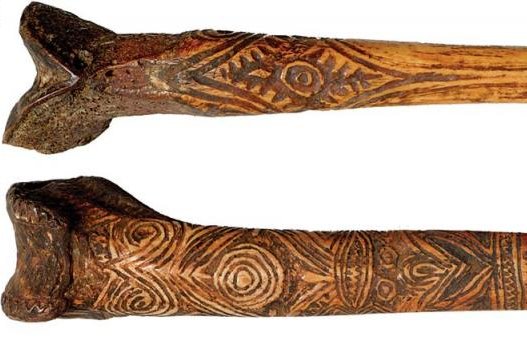1 of 2 | The most intricate carvings were engraved into the handles of the bone daggers. Photo by Hood Museum of Art/Dartmouth College/Dominy NJ. et al./Royal Society Open Science
April 25 (UPI) -- As recently as a century ago, the people of New Guinea were carving daggers from the thighbones of cassowaries, flightless, dinosaur-like birds. The most feared and respected warriors, however, wielded daggers carved from the femurs of either their vanquished enemies or their deceased fathers.
A new study, published this week in the journal Royal Society Open Science, details the history of bone daggers in New Guinea and their symbolic importance to the island's native populations.
Nathaniel Dominy, a professor of anthropology at Dartmouth College, has been studying bone daggers for several years. The latest study was inspired by his discovery of a drawer full of bone weapons at Dartmouth's Hood Museum of Art.
Historical accounts of New Guinea's bone daggers appear in the 18th century writings of anthropologists and missionaries. Some descriptions claim the daggers were used to finish off enemies at close range with a stab to the neck -- opponents who were wounded by arrows at long-range. Other accounts claim daggers were also used to cannibalize prisoners.
"The veracity of these accounts is difficult to assess," Dominy and his colleagues wrote in their newly published paper.
Though some accounts may be fabricated or exaggerated, the latest research suggests the bones were definitely put to violent ends.
"These are only used for hand-to-hand combat," Dominy told the Washington Post. "You both are trying to stab each other in the nape in the same time and twist."
While the daggers certainly had a utilitarian purpose, their symbolic qualities are most striking. Warriors of higher status wielded daggers carved from the femurs of respected men, some from their dead fathers and some from their adversaries.
Intricate carvings lent the daggers additional symbolic power. The most involved designs were carved into the handle, so those holding the dagger could sense its power through touch.
Because daggers carved from human bones maintained the natural curvatures of the femur, they were superior to those carved from the thighbones of cassowaries. But bird bone daggers were capable of killing, too. The dagger withstood 44 pounds of pressure before it snapped.
As part of the study, Dominy and his research partners purchased a dagger carved from a cassowary bone and subjected it to strength tests. CT scans showed both types of bone daggers were equally dense.
"It looks like both bone types are equally suited for making daggers," Dominy told Live Science. "The difference is that when men are shaping human daggers, they're retaining a lot of the curvature, which gives it a natural, superior strength."
It's likely warriors took extra care to carve daggers from human bones, paying less attention to those carved from easily replaceable cassowary bones.















